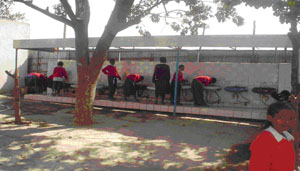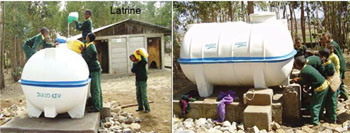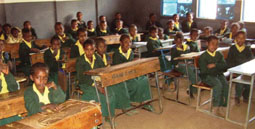5.3.2 Components of school hygiene and sanitation
You have been a school student at some time in the past. What were the components of school health services in your time?
You might have various memories of events. Your classroom teacher might have checked your personal hygiene. You might have learned about trachoma and face washing in science class. Someone might have reminded you to use the latrine and wash your hands afterwards.
Your concern as a healthworker is the need to check systematically:
- health-related policies in schools
- hygiene
- safe water supply
- sanitation.
We will discuss these and other aspects of the school environment in turn.
Health-related policies in schools
All schools should be aware of the importance of school hygiene and sanitation for their students. Promotion of hygiene, organising hygiene/health clubs, having a clean school compound and supervising classrooms for their cleanliness are some of the items that require the attention of the woreda and kebele school authorities. The implementation of policy statements must take into account the availability of human resources and materials.
Promoting hygiene
Teaching students about health focuses mainly on the dissemination of hygiene information aimed at changing or modifying their behaviour. Health information is usually incorporated within various school subjects such as science, biology, home economics and physical education. However, teaching aimed at changing the behaviour of students is not part of the traditional education system. There are ways to fill this gap. Setting up and supporting health or hygiene clubs in schools, and the effective involvement of the Health Post, are important. You can take an active role in this by regular inspection and advising the school community in your area. You can take an active lead in coordinating and involving existing local health facilities in the promotion of school hygiene and sanitation. Detailed information on how to plan, organise and deliver health messages for school health promotion is found in the Health Education, Advocacy and Community Mobilisation Module.
The benefits of personal hygiene practice have been discussed in Study Session 3.
Which components of personal hygiene are most important to students?
Keeping the body clean, face and handwashing, wearing clean clothes, foot hygiene, and nail care are all important to students.
Healthy school environment
The physical and aesthetic values of the school environment and physical buildings need to satisfy the physical, physiological and psychological development of students. The important aspects of a safe and healthful school environment are:
- Adequate classroom space to avoid crowding. The Ministry of Health recommends: 2 m2 per student at kindergartens; 1.11 m2 per student at primary school; 1.26 m2 per student at secondary schools.
- Classrooms with adequate daylight and ventilation; the proportion of window to floor area should be 25%.
- Classrooms that protect students’ vision through the appropriate distance between the blackboard and the first line of seats.
- Dimensions of desks and chairs that match the students’ physical development.
- The location of the school should be free from any potential physical and chemical hazards (e.g. free from noise and air pollution).
- Playing areas for physical exercise.
You should work in collaboration with the appropriate experts of the woreda education office for the satisfaction of the above needs. This can be discussed at the kebele cabinet meetings.
Provision of drinking water
Many students may walk hours to get to school. The provision of safe water for drinking and personal hygiene is important and there needs to be adequate facilities in proportion to the number of students. The Ministry of Health advises one water tap per fifty students. Low-cost water fountains and water taps arranged in a water trough design are acceptable for schools. They should be mounted at the appropriate height from the ground surface to match the height of the students (Figure 5.2). Water availability should be about five litres per day per student and water must be available throughout the school day. A water storage tank may be necessary to provide water reserves and satisfy the demand at peak hours. The sullage (wastewater) that results because of handwashing must be drained to a seepage or soak pit, or ditch.

Provision of latrines
The provision of latrines is also extremely important. In addition, separate latrines for girls and boys need to be provided to encourage girls to continue their education. The usual type of latrine at schools is a communal dry pit latrine equipped with a vent.
School latrines should meet the following requirements:
- They must be located away from the classroom in order to avoid interfering with the students’ learning process. They must be reasonably accessible.
- They must be well-maintained and agreeable to use. They should provide privacy and security.
- The dimensions of the latrine must be adequate to accommodate the storage needs for three to five years. You will learn more about this in the waste management sessions later in this Module.
- There must be handwashing facilities near the latrine (Figure 5.3). Handwashing with soap after using the latrine and before lunch must be encouraged.
- There should be separate latrines for male and female students. Latrines for teachers must be separated as well.
- There must be a bucket with water and a jug inside female latrines. This is essential for cleaning the bottom for female students during menstruation.
- In primary and secondary schools, there should be one latrine for every 30 students and one urinal for every 50 male students.
- Latrines should be hygienic to use and easy to clean. Students themselves should participate in daily cleaning of the latrine. The hygiene/health club should take the leading role in the maintenance of latrine cleanliness.

Provision of solid waste management facilities
Discarded paper and cartons are the usual type of waste at schools. There could also be chemical wastes from school laboratories. Schools should have the following facilities:
- Waste bins/buckets in each classroom and teacher’s office. Waste bins may be placed in the school compound where deemed necessary (around corridors, playgrounds).
- Waste disposal pit at an appropriate location; a local incinerator can be used if the amount of school solid waste is significant.
Classroom sanitation
The cleanliness of the classroom is vital for a good learning process. Students should be involved in the maintenance of classroom cleanliness on a daily basis. The floor of the classroom should be smooth to reduce dust (Figure 5.4). Dust and cracks in the floor must be avoided because these are good hiding sites for biting animals such as the chigger (also known as the chigger red bug or harvest mite).

5.3.1 Public health importance of school hygiene and sanitation
